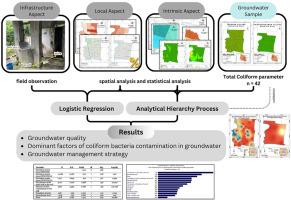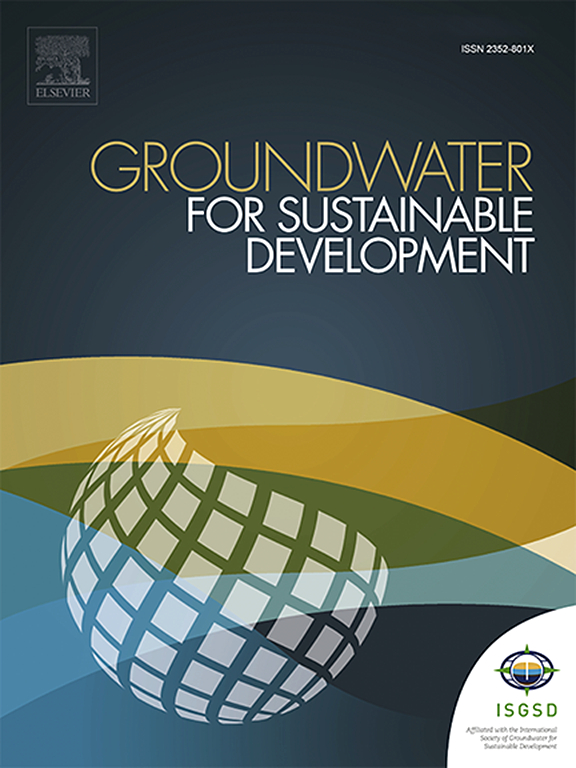调查浅层地下水大肠菌群污染的主要因素:逻辑回归和 AHP 方法
IF 4.9
Q2 ENGINEERING, ENVIRONMENTAL
引用次数: 0
摘要
在印度尼西亚等发展中国家,浅层地下水是清洁水的重要来源。然而,由于基础设施不足,人口增长导致水质下降。本研究旨在确定造成浅层地下水大肠菌群污染的主要因素,解决以往大规模研究中缺乏详细统计和多标准分析的问题。研究在印度尼西亚日惹人口稠密的城市地区进行,以 42 个地下水样本的总大肠菌群测量值作为自变量。共有 14 个因变量,分为三个方面:基础设施(如水井类型、井深、井壁、DEWATS 类型、水井与化粪池、厕所和其他污染源的距离);特定变量(如人口密度和土地利用);内在变量(如地下水位、降雨量、土壤类型和坡度)。使用 IBM SPSS 26 软件对这些参数进行了逻辑回归统计分析,并使用专家选择软件的层次分析法(AHP)对这些因素进行了优先排序。结果表明,83.3% 的浅层地下水样本的总大肠菌群超过了可接受限值,主要因素包括水井与其他污染源的距离、坡度、与化粪池的距离、地下水位和人口密度。这些发现强调了在管理地下水质量时考虑复杂环境因素的重要性,尤其是在发展中国家。建议地方当局实施更严格的法规并改善基础设施,以降低污染风险。本文章由计算机程序翻译,如有差异,请以英文原文为准。

Investigating dominant factors of coliform contamination in shallow groundwater: A logistic regression and AHP approach
Shallow groundwater is a crucial source of clean water in developing countries like Indonesia. However, population growth has led to declining water quality due to inadequate infrastructure. This study aimed to identify dominant factors contributing to coliform contamination in shallow groundwater, addressing the lack of detailed statistical and multicriteria analyses in previous large-scale studies. The study was conducted in a densely populated urban area in Yogyakarta, Indonesia, and total coliform measurements from 42 groundwater samples were used as the independent variable. There are 14 dependent variables, categorized into three aspects: infrastructure (e.g., well type, well depth, wall of well, DEWATS type, well distance to the septic tank, latrine, and other contaminant sources); specific (e.g., population density and land use); and intrinsic (e.g., groundwater level, rainfall, soil type, and slope). Those parameters were statistically analyzed using logistic regression with IBM SPSS 26 software, and supported by the Analytical Hierarchy Process (AHP) that was employed using Expert Choice software to prioritize the factors. The results showed that 83.3% of the shallow groundwater samples exceeded the acceptable limits for total coliform, with key factors including well's proximity to other contamination sources, slope, distance from septic tanks, groundwater level, and population density. These findings highlight the importance of considering complex environmental factors in managing groundwater quality, particularly in developing countries. It is recommended that local authorities implement stricter regulations and infrastructure improvements to mitigate contamination risks.
求助全文
通过发布文献求助,成功后即可免费获取论文全文。
去求助
来源期刊

Groundwater for Sustainable Development
Social Sciences-Geography, Planning and Development
CiteScore
11.50
自引率
10.20%
发文量
152
期刊介绍:
Groundwater for Sustainable Development is directed to different stakeholders and professionals, including government and non-governmental organizations, international funding agencies, universities, public water institutions, public health and other public/private sector professionals, and other relevant institutions. It is aimed at professionals, academics and students in the fields of disciplines such as: groundwater and its connection to surface hydrology and environment, soil sciences, engineering, ecology, microbiology, atmospheric sciences, analytical chemistry, hydro-engineering, water technology, environmental ethics, economics, public health, policy, as well as social sciences, legal disciplines, or any other area connected with water issues. The objectives of this journal are to facilitate: • The improvement of effective and sustainable management of water resources across the globe. • The improvement of human access to groundwater resources in adequate quantity and good quality. • The meeting of the increasing demand for drinking and irrigation water needed for food security to contribute to a social and economically sound human development. • The creation of a global inter- and multidisciplinary platform and forum to improve our understanding of groundwater resources and to advocate their effective and sustainable management and protection against contamination. • Interdisciplinary information exchange and to stimulate scientific research in the fields of groundwater related sciences and social and health sciences required to achieve the United Nations Millennium Development Goals for sustainable development.
 求助内容:
求助内容: 应助结果提醒方式:
应助结果提醒方式:


